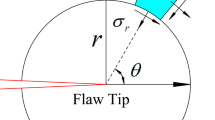Abstract
By the use of the Griffith model, the propagation of a crack in a solid subjected to a cyclic loading is studied. It is assumed that all the energy lost per cycle in the Bauschinger process is transferred to the crack to increase its size.
The paper is divided in two parts, the first dealing with materials which do not undergo work-hardening and the second with materials subjected to said phenomenon during cyclic loading. Notwithstanding the crude approximation of this model, it is shown that the main features of fatigue phenomena are accounted for.
Résumé
L'étude de la propagation d' une fissure dans un solide soumis à des charges cycliques a été entreprise en partant du modèle de Griffith, et d' une hypothèse selon laquelle 1' énergie dissipée au cours de chaque cycle d'hystéresis sert intégralement à accroitre la dimension de la fissure.
On considère séparément le cas des materiaux qui ne subissent pas un durcissement en cours de sollicitation cyclique, et le cas des materiaux qui sont sujets à un tel durcissement.
Malgré la faiblesse des hypotheses de base, due à lent caractère de grossière approximation, les résultats de l'analyse concordent qualitativement avec les caractéristiques principales du phénomène de fatigue.
Zusammenfassung
DurchGebrauch des Griffithschen Models, wind die Fortpflanzung eines Risses in einem zyklischbeladenenfesten Körper studiert. Es wird angenommen, dass alle in einem Zyklus verlorene Energie während des Bauschingerverfahrens zum Riss übergehen wird, um dessen Grösse zu erweiters.
Das Werk umfasst zwei Teile. Der erste Teil behandelt Stoffe, die der Bearbeitungsverhärtung nichtausgesetzt siud; and der zweite Tell Stoffe, die dem Verfahren während zyklischer Belastung uaterworfen werden. Trotz dergrossen Annäherung dieses Models, wird gezeigt, dass die Hauptzüge der Zermürphassomeneerklärt werden.
Similar content being viewed by others
References
A.A. Griffith Phil. Trans. Royal Soc. A221, 163 (1920).
H.L. Marcuset al.Inter. J. of Frac. Mech., 1, 156, (1965).
W.P. MasonJ. Acoustical Amer. Soc. 28, 1197 (1956).
W.P. MasonJ. Acoustical Amer. Soc. 28, 1207 (1956).
W.P. Mason Internal friction, plastic strain and fatigue in metals and semiconductors, “Basic mechanism of fatigue” ASTM Spec. Pub. n.237 (1960).
L. F. Coffin Cyclic straining and fatigue, Internal Stresses and Fatigue of Metals, Elsevier (1959).
L. F. Coffin, I. Tavernelli: and Am. Soc. for Metals-Preprint n.112 (1958).
L. LocatiLa fatica dei materiali metallici - Hoepli (1950).
R. F. Hanstock Inter.Conf. on Fatigue of Met.- J. Mech.Eng. (1956).
M. Thompson and N. J. Wadsworth Metal Fatigue -Advances in Physics 7, 72 (1958).
Author information
Authors and Affiliations
Rights and permissions
About this article
Cite this article
Gallina, V., Galotto, C.P. & Omini, M. On a possible model of crack propagation in a solid subjected to a cyclic loading. Int J Fract 3, 37–44 (1967). https://doi.org/10.1007/BF00188644
Issue Date:
DOI: https://doi.org/10.1007/BF00188644




